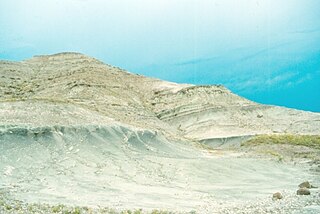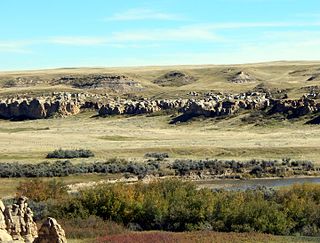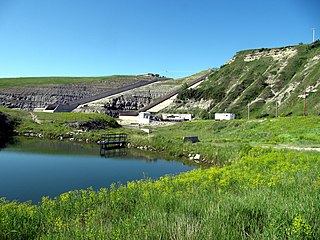| Claggett Shale Stratigraphic range: Late Cretaceous, Campanian | |
|---|---|
| Type | Geological formation |
| Underlies | Judith River Formation |
| Location | |
| Region | North America |
The Claggett Shale is a geological formation in Montana whose strata date back to the Late Cretaceous. Dinosaur remains are among the fossils that have been recovered from the formation. [1]

The Lance (Creek) Formation is a division of Late Cretaceous rocks in the western United States. Named after Lance Creek, Wyoming, the microvertebrate fossils and dinosaurs represent important components of the latest Mesozoic vertebrate faunas. The Lance Formation is Late Maastrichtian in age, and shares much fauna with the Hell Creek Formation of Montana and North Dakota, the Frenchman Formation of southwest Saskatchewan, and the lower part of the Scollard Formation of Alberta.

The Two Medicine Formation is a geologic formation, or rock body, that was deposited between 83.5 ± 0.7 Ma and 70.6 ± 3.4 Ma, during Campanian time, and is located in northwestern Montana and southern Alberta. It crops out to the east of the Rocky Mountain Overthrust Belt, and the western portion of this formation is folded and faulted while the eastern part, which thins out into the Sweetgrass Arch, is mostly undeformed plains. Below the formation are the nearshore deposits of the Virgelle Sandstone, and above it is the marine Bearpaw Shale. Throughout the Campanian, the Two Medicine Fm. was deposited between the western shoreline of the Late Cretaceous Interior Seaway and the eastward advancing margin of the Cordilleran Overthrust Belt. The Two Medicine Fm. is mostly sandstone, deposited by rivers and deltas.

The Judith River Formation is a fossil-bearing geologic formation in Montana, and is part of the Judith River Group. It dates to the Late Cretaceous, between 80 and 75 million years ago, corresponding to the "Judithian" land vertebrate age. It was laid down during the same time period as portions of the Two Medicine Formation of Montana and the Oldman Formation of Alberta. It is an historically important formation, explored by early American paleontologists such as Edward Drinker Cope, who named several dinosaurs from scrappy remains found here on his 1876 expedition. Modern work has found nearly complete skeletons of the hadrosaurid Brachylophosaurus.

The Cloverly Formation is a geological formation of Early Cretaceous age that is present in parts of Montana, Wyoming, Colorado and Utah in the western United States. It was named for a post office on the eastern side of the Bighorn Basin in Wyoming by N.H. Darton in 1904. The sedimentary rocks of formation were deposited in floodplain environments and contain vertebrate fossils, including a diverse assemblage of dinosaur remains. In 1973, the Cloverly Formation Site was designated as a National Natural Landmark by the National Park Service.

The Bearpaw Formation, also called the Bearpaw Shale, is a geologic formation of Late Cretaceous (Campanian) age. It outcrops in the U.S. state of Montana, as well as the Canadian provinces of Alberta and Saskatchewan, and was named for the Bear Paw Mountains in Montana. It includes a wide range of marine fossils, as well as the remains of a few dinosaurs. It is known for its fossil ammonites, some of which are mined in Alberta to produce the organic gemstone ammolite.

The Arundel Formation, also known as the Arundel Clay, is a clay-rich sedimentary rock formation, within the Potomac Group, found in Maryland of the United States of America. It is of Aptian age. This rock unit had been economically important as a source of iron ore, but is now more notable for its dinosaur fossils. It consists of clay lenses within depressions in the upper part of the Patuxent Formation that may represent oxbow swamp facies. It is named for Anne Arundel County, Maryland.
The Milk River Formation is a sandstone-dominated stratigraphic unit of the Western Canada Sedimentary Basin in southern Alberta, Canada. It was deposited in near-shore to coastal environments during Late Cretaceous time. Based on uranium-lead dating, palynology and stratigraphic relationships, deposition occurred between ~84.5 and 83.5 Ma.
The Bauxite of Cornet is a geological formation in Romania whose strata date back to the Early Cretaceous. Dinosaur remains are among the fossils that have been recovered from the formation. It exists as karstic sediments infilling fissures and caves in limestone.

The Foremost Formation is a stratigraphic unit of Late Cretaceous (Campanian) age that underlies much of southern Alberta, Canada. It was named for outcrops in Chin Coulee near the town of Foremost and is known primarily for its dinosaur remains and other fossils.

The St. Mary River Formation is a geologic formation of Late Cretaceous age of the Western Canada Sedimentary Basin in southwestern Alberta and northwesternmost Montana. It was first described from outcrops along the St. Mary River by George Mercer Dawson in 1883, and it takes its name from the river.
The Fort Crittenden Formation is a geological formation in Arizona whose strata date back to the Late Cretaceous. Dinosaur remains are among the fossils that have been recovered from the formation.

The Aguja Formation is a geological formation in North America, exposed in Texas, United States and Chihuahua and Coahuila in Mexico, whose strata date back to the Late Cretaceous. Dinosaur remains are among the fossils that have been recovered from the formation.
The Eagle Sandstone, originally the Eagle Formation, is a geological formation in Montana whose strata date back to the Late Cretaceous. It is a light to brownish gray to pale yellow-orange, fine-grained sandstone. It contains areas of crossbedding and local shale members. It contains large sandy calcareous concretions. Its thickness varies from 100 to 350 feet due to the lens nature of the individual sandstone layers and local interbedded sandy shale layers.
The Livingston Formation is a geological formation in Montana whose strata date back to the Late Cretaceous. Dinosaur remains are among the fossils that have been recovered from the formation.
The Frontier Formation is a sedimentary geological formation whose strata date back to the Late Cretaceous. The formation's extents are: northwest Colorado, southeast Idaho, southern Montana, northern Utah, and western Wyoming. It occurs in many sedimentary basins and uplifted areas.
The Almond Formation is a geological formation in Wyoming whose strata date back to the Late Cretaceous. Dinosaur remains are among the fossils that have been recovered from the formation.
La Bocana Roja Formation is a geological formation in Baja California, Mexico whose strata date back to the Late Cretaceous. Dinosaur remains are among the fossils that have been recovered from the formation.
The Minhe Formation is a geological formation in northwestern China, whose strata date back to the Late Cretaceous period.

The Mowry Shale is a Late Cretaceous geologic formation. The formation was named for Mowrie Creek, northwest of Buffalo in Johnson County, Wyoming. The Mowry crops out or occurs at depth in parts of Colorado, Montana, North Dakota, South Dakota, Utah and Wyoming. It occurs within the following geologic regions:
| This paleontological site article is a stub. You can help Wikipedia by expanding it. |
| This article about a specific stratigraphic formation in Montana is a stub. You can help Wikipedia by expanding it. |